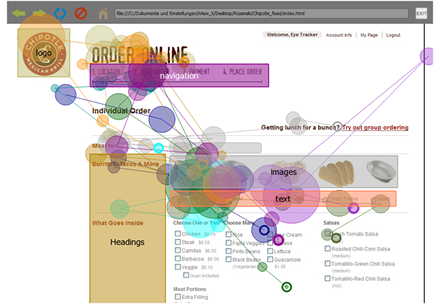



Background
With the advent of the internet the possibility of online ordering has become a reality and is now being used by several restaurants. Improving the overall customer experience is what online ordering seems to address; it eliminates the need to wait in line, affords the ability to see the whole menu anywhere and store favorites, and provides several payment methods (which can also be stored). This eye-tracking study explored the concept of efficiency and user satisfaction of the online ordering website for the popular restaurant chain, Chipotle. We also analyzed whether the website is a suitable substitution for operations that take place in the physical location and whether visiting the store impacts the ease of executing orders via Chipotle's website.
Process

Results
The study turned up some interesting results. For a task where the participant was asked to freeview the online ordering page, images may have been the most attention-grabbing upon first look at the page (Figure 1)
It was interesting to note that participants tended to look up at the top navigation area right away for a task that involved first 3 seconds of free viewing. However only one participant actually looked at the logo. We had originally expected people would look more at the logo and the ignore the side headings. Also, it can be seen that people tended to start looking in the middle of the page and look up to the top portion (largely disregarding the lower portion of the page). (Figure 2)
Some areas of interest (AOI) are selected below in Figure 3. The two areas of interest include the top navigational header that is colored purple and named "navigation" in the information boxes. The other AOI is in red and labeled "X". This section groups the menu items (entrees) that can be customized with the ingredients below (shown in Figure 2). The entrees options on the menu are: burrito, bowl, soft tacos, crispy tacos and salad. Figure 3 shows the first 15 seconds of the task. Studying the first 15 seconds revealed that the top navigational header was looked at 9 out of 11 times (as determined by a fixation time of 80 ms). This shows that the top header area was noticed and evidence from Figure 2 also support this trend.
Figure 4 below attempted to determine if people were looking at the images or the labeled radio button with text (for example: AOI 005 in Figure 4). It is important to note that the radio button is selected regardless of if one clicks on the image of the food above, or within the radio button itself which is the normal usage.
 Figure 1
Figure 1
 Figure 2
Figure 2
 Figure 3
Figure 3
 Figure 4
Figure 4